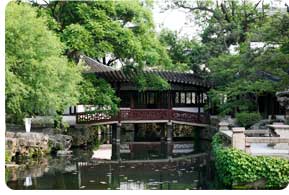 The Humble Administrator’s Garden The Humble Administrator’s Garden
拙政园
The Humble Administrator's Garden. First laid out in 1509 AD, the garden's scenery is focused on a central pond with various buildings of pavilions,terraces,chambers and towers located by the water or on hillocks in a natural, unsophisticated,and appropriate composition. The garden is most representative of Chinese classical gardens in the Ming Dynasty.
The Humble Administrator's Garden covers 4 hectares in northeast Suzhou. It is the largest garden of the city and a typical example of the art of horticulture south of the Changjiang river. It was laid out in 1513 by the censor Wang Xiancheng after his retirement from political life. He named the garden after an essay by Pan Yue of Jing Era---On Idle Living:" Building house and planting trees, watering garden and growing vegetables are the affairs (Zheng) of humble (Zhuo) people." After his death, his son gambled away the garden.
When Taiping troops occupied Suzhou in 1860, King Zhongwang picked this one and the neighboring buildings of the present Historical Museum as a residence and center for his political activities.
Three-fifths of its area is covered by magnificent ponds. All of the buildings are right next to the ponds, so that the garden seems to be floating on the water. The entire grounds can be divided into three parts: an eastern, a central and a western part. The central one is especially worth a visit. It centers around Yuanxiang Tang pavilion. Two artificial islands linked to each other in the lotus pond north of the pavilion are densely overgrown with bamboo plants and trees. In the western part, Sanshiliu Yuanyang Guan hall, the Hall of the Thirty-Six Mandarin Ducks, will attract the visitors' special interest. On the adjoining lake, one used to be able to see mandarin ducks, symbol of marital faithfulness. Today, some swim in a fenced-off part of the lake.West of the garden there is a noteworthy bonsai exhibition a teahouse.
|



